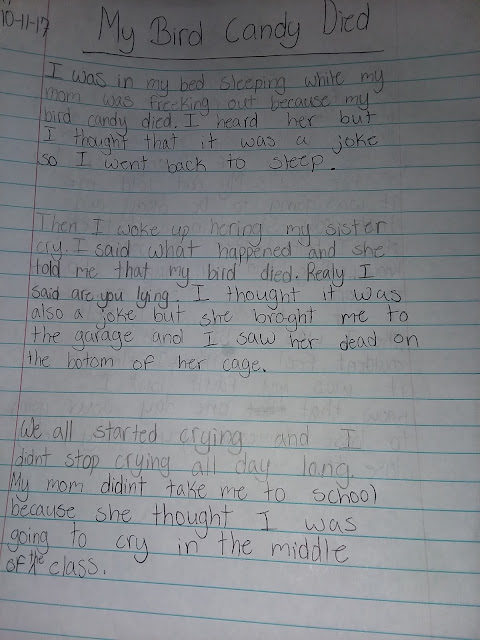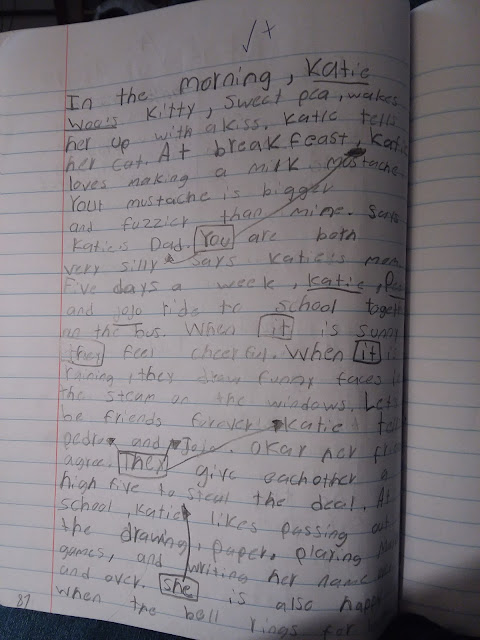I had a very pleasant time on Thursday. I was able to go into a classroom and teach a revision lesson to fourth grade students. We worked on what it means to revise. I first entered the classroom with the book
Hair by Sandra Cisneros. I used to book to as a Reading and Writing connection.
First, I had the fourth grade writers come to the convening area near a white board. I introduced myself as, "My name is Ms. Ucles. I am a writer." I asked the other students to introduce themselves as writers. They did so. Then I asked them a question, "What do writers do?" They gave me lots of answers. Then I asked, "What does revision mean to you?" They gave me varied answers. I then wrote the word revision on the board. I told them,"Revision means many those things that you just mentioned. To me, revision is creating the magic for the reader. I don't mean spells or taking a rabbit out of a hat. I mean that once I get my words down, I now have the opportunity to take my writing to new heights for the reader. I can go from okay, to better, to best just by revising. Today, we are going to do just that."
I then read them the book Hair to the students. When I finished reading it out loud, I asked them to think of something that the book reminded them of in their lives. I said, "When I read this book, as I was saying it reminds me of my grandma and how she used to pin her hair up with these black little curlers. The whole apartment smelled like the get Dippety Do. When I would come over to visit, she would have her hair pinned up with a plastic cap on her head. It also reminded me of my mom who used to do the same thing. I remember the curlers and the hair dryer she used to use on Saturday nights. What does this book remind you of?"
Some students gave various answers. "Today, you will write about those connections for 5 minutes. We won't talk, but write about our connections. Then after five minutes, we will reconvene." The students and I wrote. The room was very quiet as everyone was writing. After five minutes, I asked the students to finish by writing their last sentence. We reconvened in the meeting area. I shared my piece. I then placed it underneath the document camera. I revealed my revision pens to the students. I purchased about 50 multicolored pens from Staples the previous day. I invited the students to pick two different colors to use. I picked a purple color to use. (Previously, I wrote with blue ink.) I told them that I used the different color ink to track the movement of my mind. The purple ink color to represent my first write. The second green color represented my first revision. It was my first attempt of creating magic for the reader. I read through my piece of writing aloud. Then I read the first sentence aloud. As I read it aloud, I revised the sentence and used the word insert and add. I then went through the rest and revised the short paragraph using green ink. I then invited the students to go back to their writing and see if they could create some writing magic. They took me up on my invitation and I watched the magic envelope the classroom. Some read theirs aloud and some didn't. I loved seeing the thinking and problem solving. They tried to make their writing better for the reader.
Finally, after 5 minutes, I asked to them to look over their writing. I read my first two sentences aloud with a before and after. I asked, "Which sounds better this way or that way?" They said, "The second sounds better." I asked, "Why?" They then explained why. I asked, "Can you see what I am talking about the second time?" "Yes," they said. "Then, I am helping the reader understand by choosing precise wording." I told them, "Now, go over what you wrote. Compare the first write to the revisions that you made. Is it better? Share with a partner your revision decisions."
Then I said, " I am going to revise again to see what happens. I don't just revise once when I write. I go through it multiple times finding ways to make my writing better for the reader. Let's find out what pops this second time." I told them that I changed pens to red to show my second attempt at creating magic for the reader. I went through and make some revision decisions with my writing, and I including them in my thinking. I then invited them to try revising a second time to see what other revision decisions they could make. They revised for five minutes and used the second colored pen. As I walked around, I could see such great thinking. So many decisions were being considered! I asked them to stop and look over their writing. I read my second revision aloud. Before I began reading, I asked them to find a their favorite part of my writing. I told them that I had one particular part that I loved and that I thought that I had nailed. I read it through. I asked them to share with a partner what their favorite part had been. They then shared out loud. I followed up with, "Why did you like it?" I then shared the pen drop moment. (Moment that you feel that your writing was great.) Most of them told me that they liked the part that I had selected. I gave them time to look over their writing and find the pen drop moment.
Finally, I shared with them the acronym RADAR.(Jeff Anderson and Kelly Gallagher
Write Like This) I said, "When we revise we sometimes replace words and phrases with others that help the reader see. Other times we add new words and sentences to make our writing clear to the reader. Still other times, we may decide to delete words and phrases that don't belong or that we might want to delete and replace with more precise and concise language. At times, my way need to reorder or rearrange sentence and paragraphs. I went through the first three sentences and asked them, "What did I do here?" With guidance, they were able to tell me. I gave them a letters to code the process. I used R for replace, A for add, D for delete, and RE for reorder or replace. After I had done modeled the process, I invited them to do the same with their writing. They did so. I think asked them to share with a partner.
After that, I invited two student volunteers to share their changes with their writing to be displayed underneath the document camera. They read it and explained what were their revision decisions. It was so cute! What a wonderful writing kind of day! Wow!
This took me 60 minutes to do with numerous school interruptions from outside the classroom. We made it work! Normally, if time is limited, this could take two days. I have left some student samples of their work. I love teaching fourth grade students!



















































